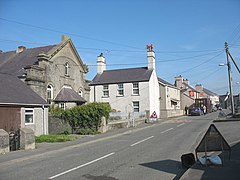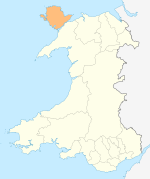
Menai Bridge is a town and community on the Isle of Anglesey in north-west Wales. It overlooks the Menai Strait and lies by the Menai Suspension Bridge, built in 1826 by Thomas Telford, just over the water from Bangor. With a population of 3,376, it is the fifth largest town on the island. The built-up area including Llandegfan had a population of 4,958.

Aberffraw is a village and community on the south west coast of the Isle of Anglesey, in Wales, by the west bank of the Afon Ffraw. The community includes Soar and Dothan. Located near the A4080 and the nearest rail station is Bodorgan.

Llanystumdwy[ɬanɪstɪmdʊɨ] is a predominantly Welsh-speaking village, community and electoral ward on the Llŷn Peninsula in Wales. It lies in the traditional county of Caernarfonshire but is currently administered as part of the unitary authority of Gwynedd. It is not regarded as being part of Llŷn, but as belonging instead to the ancient commote of Eifionydd on the Cardigan Bay coast, where it has its own beach. The community includes the villages of Chwilog, Afon Wen, Llanarmon, and Llangybi, plus the hamlets of Rhoslan and Pencaenewydd.

Moelfre is a village, a community and, until 2012, an electoral ward on the north-east coast of the Isle of Anglesey in Wales. The community area covers the village and harbour, and several smaller, dispersed settlements. It includes six scheduled Iron Age hut groups and many other sites of archaeological interest. The harbour was formerly a local fishing port; a lifeboat station has been based here since 1854. Among many shipwrecks off the coast was that of the Royal Charter in 1859. Near the modernised lifeboat station is the RNLI Seawatch Centre. The coastline includes a rocky headland north of the village and a large sandy beach at Lligwy Bay, both traversed by the Anglesey Coastal Path. The 2011 census measured the village population as 710. It was estimated at 614 in 2019.
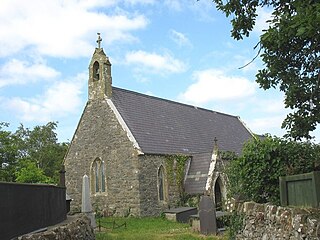
Llanddaniel Fab is a village and community in Anglesey, Wales. At the 2001 census it had a population of 699, increasing to 776 at the 2011 census.

Llanddeusant is a small linear village, on Anglesey, North Wales about 10 miles (16 km) north east of Holyhead. The village takes its name from its parish church which is dedicated to St. Marcellus and Saint Marcellina.

Ambleston is a village, parish, and community in Pembrokeshire, Wales, lying seven miles (11 km) north-north-east of Haverfordwest. The parish includes the hamlets of Wallis and Woodstock.

Bryngwran is a village and community in Anglesey Wales, located on the A5 trunk road. It lies 8.1 miles (13.0 km) west of Llangefni, 7.0 miles (11.3 km) south west of Llannerch-y-medd and 7.4 miles (11.9 km) south east of Holyhead, and includes the villages of Bryngwran, Capel Gwyn and Engedi.

Anglesey is an island off the north-west coast of Wales. It forms a principal area known as the Isle of Anglesey, that includes Holy Island across the narrow Cymyran Strait and some islets and skerries. Anglesey island, at 260 square miles (673 km2), is the largest in Wales, the seventh largest in Britain, largest in the Irish Sea and second most populous there after the Isle of Man. Isle of Anglesey County Council administers 276 square miles (715 km2), with a 2011 census population of 69,751, including 13,659 on Holy Island. The Menai Strait to the mainland is spanned by the Menai Suspension Bridge, designed by Thomas Telford in 1826, and the Britannia Bridge, built in 1850 and replaced in 1980. The largest town is Holyhead on Holy Island, whose ferry service with Ireland handles over two million passengers a year. The next largest is Llangefni, the county council seat. From 1974 to 1996 Anglesey was part of Gwynedd. Most full-time residents are habitual Welsh speakers. The Welsh name Ynys Môn is used for the UK Parliament and Senedd constituencies. The postcodes are LL58–LL78. It is also a historic county of Wales.

Llyn Llywenan is a lake in western Anglesey, Wales found just over 1 kilometre (0.6 mi) north of the village of Bodedern and 9 kilometres (5.6 mi) east of the town of Holyhead. At a maximum length of 1.1 kilometres (0.7 mi) and breadth of 0.4 kilometres (0.2 mi) it has a surface area of only 0.4 square kilometres (0.2 sq mi). This makes it the largest natural lake on the island—both Llyn Alaw and Llyn Cefni are larger but are man made.

St Pabo's Church, Llanbabo is a medieval church in Llanbabo, in Anglesey, North Wales. Much of the church dates to the 12th century, and it is regarded as a good example of a church of its period that has retained many aspects of its original fabric. The church houses a tombstone slab from the 14th century, depicting a king with crown and sceptre, bearing the name of Pabo Post Prydain, the reputed founder of the church. However, there is no evidence that Pabo, a 5th-century prince, lived in the area and the tradition that he founded the church has little supporting basis.
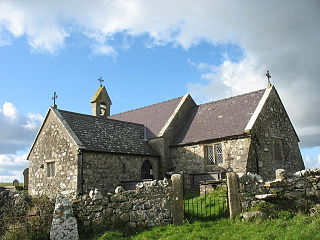
St Peulan's Church, Llanbeulan is a redundant Anglican church in Llanbeulan, in Anglesey, north Wales. The nave, which is the oldest part of the building, dates from the 12th century, with a chancel and side chapel added in the 14th century. The church has a font of early date, possibly from the first half of the 11th century: one historian has said that it would initially have been used as an altar and that "as an altar of the pre-Norman period it is a unique survivor in Wales and, indeed, in Britain".

Capel Lligwy is a ruined chapel near Rhos Lligwy in Anglesey, north Wales, dating back to the first half of the 12th century. The chapel's original purpose is unknown, but it might have been used as a memorial chapel or in connection with a local royal court, or as a chapel of ease in a large parish with a growing population. It was used for a time until the early 18th century as a private place of worship for a nearby house, then later fell into disrepair. The walls still remain, with some traces of render on them internally, but there is no roof.

Llaneilian is a village and community in the Welsh county of Anglesey. It is located in the north east of the island, 2.2 miles (3.5 km) east of Amlwch, 16.5 miles (26.6 km) north west of Menai Bridge and 12.5 miles (20.1 km) north of Llangefni. The community includes the villages and hamlets of Dulas, Llaneilian, Pengorffwysfa, Cerrig Man and Penysarn, Gadfa and Nebo, and at the 2001 census had a population of 1,192, decreasing slightly to 1,186 at the 2011 Census. The parish is crowned by its hill, Mynydd Eilian, a HuMP, popular with walkers and ramblers, and its beach, Traeth Eilian, which is popular with holidaymakers and for watersport activities. At the north easternmost point is Point Lynas,, while Ynys Dulas lies off the North East coast of the island, east of Dulas Bay.
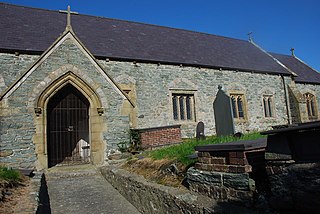
St Edern's Church, Bodedern is a medieval parish church in the village of Bodedern, in Anglesey, north Wales. Although St Edern established a church in the area in the 6th century, the oldest parts of the present building date from the 14th century. Subsequent alterations include the addition of some windows in the 15th century, and a chancel, transept and porch in the 19th century, when the nave walls were largely rebuilt. Stained glass was also inserted into the windows of the chancel and transept.

Tref Alaw is a community in Anglesey, north Wales. The community takes in the area west and south west of the Llyn Alaw, a man made reservoir which is also the largest body of water on the island. The community consists of a wide network of dispersed farms, and five settlements. Two small villages, close to each other in the centre of the community area are Llanddeusant and Elim. Llantrisant is a hamlet a mile or so to the south-west of Elim. In the north west is the small village of Llanbabo, and in the far south is the tiny hamlet of Llechgynfarwy, of which the principal building is St Cynfarwy's Church. At the 2001 census the community had a population of 606 inhabitants, reducing to 581 at the 2011 census.

Rhosybol is a village in Anglesey, Wales. The community population at the 2011 census was 1,078. Located 2.5 miles (4.0 km) south of the town of Amlwch, the village is close to both Llyn Alaw, the largest body of water on the island, and Parys Mountain, the site of the historic copper mines which lies just to the north. It is to the mines that the village owes its existence as it was one of several built to house the miners. During the 1960s noted painter Kyffin Williams produced an oil painting of the village.

In the United Kingdom, the term listed building refers to a building or other structure officially designated as being of special architectural, historical, or cultural significance; Grade II* structures are those considered to be "particularly important buildings of more than special interest". Listing was begun by a provision in the Town and Country Planning Act 1947. Once listed, strict limitations are imposed on the modifications allowed to a building's structure or fittings. In Wales, the authority for listing under the Planning Act 1990 rests with Cadw.
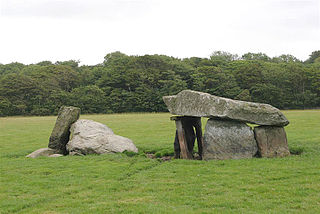
Presaddfed Burial Chamber is a listed monument in Anglesey, north Wales, comprising two Neolithic chamber tombs. It is a scheduled ancient monument and is located a short distance northwest of Bodedern. It is maintained by Cadw.
Presaddfed Hall is a small Grade II* listed country house that stands amongst woodlands to the northeast of Bodedern, Wales, at the southern tip of Llyn Llywenan. Today the hall is a self-catering accommodation for rent. A walled garden lies to the east of the house.
